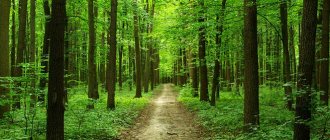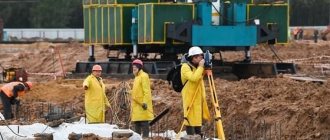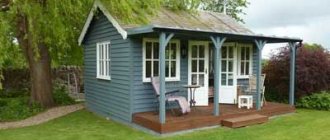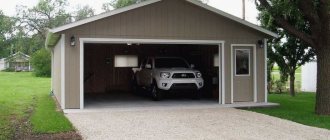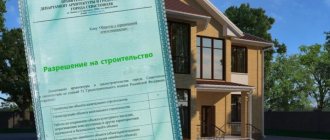Legislation in the field of forest protection
Regulatory acts that ensure interaction between citizens and administration:
- Forest Code;
- Land Code;
- Civil Code;
- federal and regional documents.
Lands for this purpose include areas within the boundaries of which forests of natural origin grow.
Their use in any form is possible only after agreement with the municipality in charge of the territory.
Categories of forest belts
Depending on the quality and quantity of trees, their value from an environmental and biological point of view, the forest fund is divided into categories according to their intended purpose:
- protective (first category): within the boundaries of the water protection zone, in protected areas (national parks and reserves), protecting soils from destruction and fields from winds. They can contain relict trees, be a habitat for rare animals, and protect the borders of the state;
- operational (second category) - used for the needs of the municipality as necessary: harvesting wood and resin, collecting food and non-food resources, hunting, agriculture, scientific and educational activities, growing seedlings, fruit and ornamental crops, construction of some facilities, processing of wood and gifts forests;
- reserve (third category) - not used and not planned for use for at least the next 20 years. The state exercises control over these lands: searching for poachers, protecting against fires, maintaining sanitary and environmental safety. Activities here are possible without deforestation and without harming the ecosystem;
- other areas that are classified as protective.
In addition to the trees themselves, the forest belt includes:
- edges, wastelands, fields surrounded by plantings;
- coastal areas of water bodies;
- objects that impede the use of forests (swamps, windbreaks);
- areas with a temporary absence of trees that are planned to be restored artificially or naturally.
These are so-called non-forest lands, which, however, are an integral part of the forest fund, as they support the ecosystem and can be used for forestry needs. A forest is an object that is considered only in its entirety:
- trees and shrubs;
- animals and birds;
- varied terrain.
What can be built in forests
The Forestry Code defines a list of possible objects for construction:
- buildings supporting the activities of forestries: lodges, permanent locations and outbuildings;
- recreation areas aimed at promoting forest conservation: ecological trails, camps;
- recreation facilities: sanatoriums, children's camps, recreation centers;
- sports and physical education buildings: forest stadiums, jogging and cycling paths;
- non-capital objects: houses for living of geologists and ecologists, builders of objects of social importance, workers involved in the development of deposits, scientific and mobile research laboratories, etc.;
- buildings for conducting religious activities.
It is prohibited to build on forest lands:
- multi-storey capital buildings;
- cottages, dachas, low-rise buildings.
To obtain permission to build such a facility on a selected territory, you must first transfer the land to another category. This is not possible in all cases. The ban on changing the category does not depend on the original purpose of the site; a decision on this is made in each specific case separately.
Features of construction on forest land
On forest fund lands, it is allowed to build only certain categories of objects built in compliance with established norms and rules that do not harm the environment.
These can be such types of non-capital objects as:
- health institutions, sanatoriums for patients with tuberculosis and pulmonary diseases;
- temporary buildings, including temporary housing for foresters and other workers monitoring the safety of the forest;
- campsites built for the purpose of providing recreation and attracting tourists, provided that significant forest areas are not cut down;
- children's holiday camps;
- physical education, health and sports facilities for training, stadiums;
- temporary buildings for carrying out scientific research, geological work, and prospecting for deposits.
Such non-capital objects will be buildings made of light structures, without buried foundation equipment and without underground structures.
Housing construction in forest belts is prohibited by law.
However, it is possible to build a building in a populated area that borders forest lands. This option is also most suitable for the construction of government institutions whose activities are not related to the exploitation of forest plantations.
Permission for the construction of a restoration or temporary facility
Before starting construction work, you need to go through the preparatory stage - inform the municipality about your plans.
The development of the forest belt is managed by the Land Committee of the region within whose borders the forest is located.
Change category
This procedure is needed when planning construction:
- sanatorium and resort buildings;
- the village, if necessary, expand the boundaries of the adjacent territory of the settlement’s lands;
- objects of natural heritage and tourism development: walking area of the national park, ecological trail;
- structures for restoration and conservation of forest resources.
Documents allowing construction
- constituent documents of the organization or passport of an individual;
- decision of the municipality on the allocation of territory for these needs, conclusion on land surveying indicating boundaries and other specifications;
- conclusion from the regional architectural and urban planning department;
- cadastral passport of the required area;
- conclusion about the absence of mineral resources in the selected territory. It is provided by Rosnedra;
- conclusion from the management of forest districts and forest resources of the region.
An application for the provision of land for construction must be sent to each department, in which you must indicate:
- purpose of construction;
- project documentation of the facility: site development plan, drawings of the future building, estimate and source of funds for construction;
- justification for the need for construction;
- confirmation of the environmental safety of the planned work: how construction will be carried out, access roads, power supply, etc.
The more detailed the application describes the work plan, the more likely it is that the Land Committee will issue a construction permit.
Lawyer for the transfer of forest fund land in Yekaterinburg
Why is it beneficial to contact our lawyer for help?
The peculiarity of the transfer of forest fund lands is that these requests do not always lead to a positive outcome. In matters of transferring the category of a land plot, representatives of the Ministry of Economic Development and the Forestry Department are involved.
If areas occupied by protective forests are planned to be developed, there is a high probability of refusal to change the form of permitted use. That is why the help of our land lawyer is so necessary in the process of transferring forest fund lands to individual housing construction (or another category of land); often at the same time it is necessary to resolve disputes about the imposition of boundaries of land plots, which also cannot be resolved without the involvement of our professional.
When reviewing the documents available to the applicant, such a specialist will immediately make an accurate forecast as to whether a positive decision from the regulatory authorities can be expected. He knows the procedure for transferring forest fund lands to other categories, so together you will spend less effort on resolving formal issues. Cooperation with our experienced lawyer in land disputes will save time and money on the way to the desired result.
Housing construction on forest lands
It is possible to build a village or build a private house using forest fund lands only if the following conditions are met:
- the desired forest area is adjacent to an already existing and functioning plot of settlement land;
- the forest belt has no cultural, ecological or industrial value: the trees, shrubs, animals, birds within the boundaries of the site are not relict or protected, the wood is not suitable for harvesting, the territory is not protected, reserved or touristic.
In this case, before construction, the category of land or Type of Permitted Use is changed without changing the category.
Personal farming
Cultivation of agricultural crops for personal use on forest lands is possible if this is permitted by the VRI (agricultural significance) in force in the territory. The territory of the forest for private household plots can be rented, taking into account compliance with environmental standards.
Regime of forest fund lands
Forest fund lands are called natural economic territories. They mostly represent a collection of different forests (both coniferous and mixed and deciduous), as well as forested and non-forested lands within the boundaries described by the provisions of the Forest Code and provided for by the Land Code, which classifies all natural territories of the country.
Depending on the category of forests, the possibility of transferring them under completely different management is determined. Thus, forests of the first category can be transferred only to satisfy state or at least municipal needs and only in exceptional cases when there are simply no other possible areas to fulfill the assigned tasks. Development of such lands by any private organizations is strictly prohibited. Forests of other categories are transferred to non-natural-economic lands in accordance with the articles of the Forest Code, which require mandatory preservation of environmental conditions and their subsequent protection during the possible creation of linear construction projects.
The types of objects being built are also regulated by forestry legislation. Thus, according to its articles, lands not used for forestry can be leased to legal entities or private entrepreneurs for a period of only up to five years (but with the possibility of extension) for their use for agricultural purposes.
Construction Features
Modern legislation prohibits private capital construction of forest areas; only certain individual buildings are permitted, made in accordance with the rules and regulations that ensure environmental protection:
- temporary buildings, as well as temporary housing for foresters and other people providing control over the condition of the forest;
- camping sites created for recreational purposes to attract tourists without directly cutting down huge forest areas;
- physical education, health and professional sports grounds for training and other sports and technical facilities, such as stadiums;
- medical and health institutions, such as a tuberculosis sanatorium or a sanatorium for pulmonary patients;
- recreational facilities that allow the population to relax and improve their health in the forest (children's camps).
Private development on forest lands is prohibited, but it is possible to settle in those settlements whose borders coincide with natural or artificial forest. The same option is possible for large government agencies not related to the use of recreational forest plantations.
In addition to capital construction, the construction of temporary structures used for one of the types of activities is permitted - studying the bowels of the earth by geologists, searching for deposits of necessary minerals, studying reservoirs or creating new roads and constructing power lines, for harvesting timber or non-timber forest resources.
Own or rent
It is impossible to obtain ownership of forest land. The state does not provide such a right, since the forest is an important strategic component of the economy and the well-being of citizens. To buy a forest plot, you need to change its category to “settlement land” or “agricultural land”.
A plot of forest can be obtained for long-term lease. The possibility of leasing is provided for forests, except for the first category (protective).
There is a greater chance of receiving temporary use of a territory that:
- has no value from an environmental point of view: it is planted with old trees and shrubs, requiring improvement;
- is a wasteland for economic purposes.
The procedure for transferring forest land
Certain translation features have been established depending on the type of forest fund. In order to put into practice the transfer of forest fund lands to another category, it is necessary to coordinate this with self-government, control, executive authorities, and Rosleskhoz.
- The transfer of forest fund lands is a lengthy procedure that requires approval by various government agencies. The application submitted by the interested party must indicate the basis for changing the form of land use. This application is submitted to the executive authority of the constituent entity of the Russian Federation .
- Subsequently, together with this body, the initial preparation and subsequent approval of the act of selection and the act of field survey of the land plot are ensured.
- It should also be noted that to carry out the translation it is necessary to conduct an environmental assessment .
- The final order on the transfer of land is prepared and issued by the Government of the Russian Federation
ATTENTION: how to win legal disputes over land plots between neighbors and other persons - watch the video. Subscribe to the YouTube channel and free consultation on land issues in the comments of the video will be professional and on time.
Easement
The use of an area with forest plantations may be partially limited, regardless of the form of ownership: ownership or lease. An easement is placed on a piece of forest by the state or privately. Reasons for imposing an easement:
- passage/passage to a body of water;
- through passage/travel in the absence of other travel options;
- driving livestock through the site;
- exploitation of land for profit;
- the need for access to linear facilities, their repair and maintenance (power lines, main pipelines);
- beekeeping;
- removal of timber in some circumstances;
- boundary and drainage works;
- Scientific research;
- picking mushrooms and berries;
- hunting.
